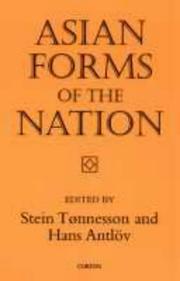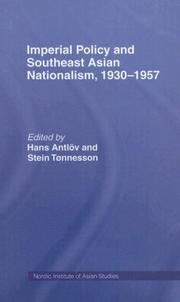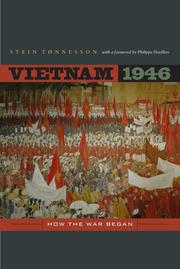| Listing 1 - 10 of 13 | << page >> |
Sort by
|
Book
ISBN: 9811647178 981164716X Year: 2022 Publisher: Singapore : Springer Singapore Pte. Limited,
Abstract | Keywords | Export | Availability | Bookmark
 Loading...
Loading...Choose an application
- Reference Manager
- EndNote
- RefWorks (Direct export to RefWorks)
This open access book explains how PRIO, the world’s oldest peace research institute, was founded and how it survived through crises. In this book, twenty-four of its researchers and associates, including Johan Galtung, Ingrid Eide, and Mari Holmboe Ruge, who founded the institute back in 1959, tell the stories of their roles in inventing and developing peace research. They reflect on their personal experiences with peace and conflict, tell what drove their peace engagement, and discuss the balance sought in the field between the cold dictates from academic rigor and the hot pursuit of peace, a desire for research to make a positive difference. Most of the chapters are interviews where one colleague interviews another. Some are self-reflective essays, while others are memorial essays written about a peace researcher who has passed away. Taken together, the book presents a lively picture of a thriving world-leading research environment and a wealth of conflicting or mutually reinforcing perspectives on war, violence, conflict, conflict management and resolution, negotiations and mediation, peacemaking, peace building, and the contested concept of peace. “The Oslo Stories is an indispensable source to the history of peace research.” Dr. Olav Njølstad, Director, Nobel Institute, Oslo
International relations --- International institutions --- Terrorism, armed struggle --- Peace research --- War and violence --- Peace building --- Conflict resolution --- PRIO --- PLO --- Oslo --- Life Stories --- Stein Tønnesson --- Stein Toennesson --- Stein Tonnesson
Book
ISBN: 2858029563 Year: 1987 Publisher: Paris L'Harmattan
Abstract | Keywords | Export | Availability | Bookmark
 Loading...
Loading...Choose an application
- Reference Manager
- EndNote
- RefWorks (Direct export to RefWorks)
anno 1940-1949 --- Indochine --- Indochinese War, 1946-1954 --- Guerre d'Indochine, 1946-1954
Book
ISBN: 0803985215 Year: 1991 Publisher: London Sage
Abstract | Keywords | Export | Availability | Bookmark
 Loading...
Loading...Choose an application
- Reference Manager
- EndNote
- RefWorks (Direct export to RefWorks)
Book
ISBN: 9788776942236 9788776942229 Year: 2017 Publisher: Copenhagen NIAS Press
Abstract | Keywords | Export | Availability | Bookmark
 Loading...
Loading...Choose an application
- Reference Manager
- EndNote
- RefWorks (Direct export to RefWorks)
Stretching from the cold steppes of Mongolia to the tropical jungles and wetlands of Indonesia, East Asia is home to 30 % of humanity. And since it is divided between 17 countries, several with border disputes or local separatist movements, it is no surprise that the region has seen its share of conflict. Indeed, for over three decades after the end of World War II, East Asia was the bloodiest place on the planet, home to several major conflicts. But then something strange happened - the region saw a steep decline in violent conflicts and in subsequent years this relative peace has actually deepened. As such, East Asia saw a dramatic drop in its share of global battle deaths from 80 % in 1946-79 to just 6.2 % in the 1980s. Since 1990 its share has been a mere 1.7 %. In recent years, a group of scholars based at Sweden's Uppsala University and led by Stein Tonnesson have investigated this so-called East Asian Peace. Instead of explaining conflict, they have sought to explain peace. The book recounts heated discussions over how to explain a regional transition to peace. Was it due to a changing power balance ? The ASEAN Way ? China's 'peaceful development' doctrine ? Growing economic interdependence ? Or (as the author contends) a series of national priority shifts by powerful Asian leaders who prioritized economic growth and thus needed external and internal stability ? The author also discusses why Thailand, Myanmar and the Philippines have not yet achieved internal peace, and includes a thorough discussion of how to predict China's future. Can China keep peace with its neighbours as well as with the USA ?
Peace --- S09/0264 --- Coexistence, Peaceful --- Peaceful coexistence --- China: Foreign relations and world politics--General works: since 1989 --- East Asia --- Foreign relations. --- EAST ASIA--FOREIGN RELATIONS --- International relations --- Disarmament --- Peace-building --- Security, International --- War
Book
ISBN: 8776946339 9788776946333 8776942236 9788776942236 8776942228 9788776942229 Year: 2017 Publisher: Copenhagen, Denmark
Abstract | Keywords | Export | Availability | Bookmark
 Loading...
Loading...Choose an application
- Reference Manager
- EndNote
- RefWorks (Direct export to RefWorks)
The fascinating and controversial (but also personal) story of a 6-year research program based at Uppsala University that, instead of explaining conflict, has sought to explain peace, and to gauge its quality and sustainability. Specifically, the program has sought to understand the dramatic drop in battle deaths in East Asia (including Southeast Asia) from the 1980s, just as warfare worsened in the rest of the world. The book recounts heated discussions to explain this 'East Asian Peace'. Was it due to a changing power balance? The ASEAN Way? China's 'peaceful development' doctrine? Growing economic interdependence? Or, as the author contends, a series of national priority shifts by powerful Asian leaders who prioritized economic growth and thus needed external and internal stability? The book also deals with civil as well as international conflict, and discusses why Thailand, Myanmar and the Philippines have not yet achieved internal peace. The author recounts his debates with colleagues who find it difficult to accept that a region with unresolved disputes, rising arms expenditure, massive human rights violations, and high domestic violence can be called 'peaceful'. East Asia, they say, has just a 'negative peace' or relative absence of war. Though he holds that a 'negative peace' has tremendous positive value, T nnesson does ponder its future. For instance, can China keep peace with its neighbors? A rare combination of detached analysis and personal narrative, the book examines developments in the world's most important region while also telling the story of how researchers with different assumptions develop rival theories and predictions. A companion volume to the main output of the Uppsala peace research program, Debating the East Asian Peace, this study will be of especial interest to not only scholars and students but also policy-makers, NGOs, businesses, journalists and many others engaged with the peace, stability and prosperity of the East Asian region.

ISBN: 0700704426 Year: 1996 Publisher: Richmond : Curzon,
Abstract | Keywords | Export | Availability | Bookmark
 Loading...
Loading...Choose an application
- Reference Manager
- EndNote
- RefWorks (Direct export to RefWorks)

ISBN: 0700703195 Year: 1995 Publisher: Richmond : Curzon,
Abstract | Keywords | Export | Availability | Bookmark
 Loading...
Loading...Choose an application
- Reference Manager
- EndNote
- RefWorks (Direct export to RefWorks)
Book
ISBN: 8203113389 Year: 1986 Publisher: København Aschehoug
Abstract | Keywords | Export | Availability | Bookmark
 Loading...
Loading...Choose an application
- Reference Manager
- EndNote
- RefWorks (Direct export to RefWorks)

ISBN: 1282359878 9786612359873 0520944607 9780520944602 9780520256026 0520256026 9781282359871 6612359870 Year: 2010 Publisher: Berkeley University of California Press
Abstract | Keywords | Export | Availability | Bookmark
 Loading...
Loading...Choose an application
- Reference Manager
- EndNote
- RefWorks (Direct export to RefWorks)
Based on multiarchival research conducted over almost three decades, this landmark account tells how a few men set off a war that would lead to tragedy for millions. Stein Tønnesson was one of the first historians to delve into scores of secret French, British, and American political, military, and intelligence documents. In this fascinating account of an unfolding tragedy, he brings this research to bear to disentangle the complex web of events, actions, and mentalities that led to thirty years of war in Indochina. As the story unfolds, Tønnesson challenges some widespread misconceptions, arguing that French general Leclerc fell into a Chinese trap in March 1946, and Vietnamese general Giap into a French trap in December. Taking us from the antechambers of policymakers in Paris to the docksides of Haiphong and the streets of Hanoi, Vietnam 1946 provides the most vivid account to date of the series of events that would make Vietnam the most embattled area in the world during the Cold War period.
Indochinese War, 1946-1954. --- Indochinese War, 1946-1954 --- Causes. --- Vietnam --- France --- China --- History --- Relations --- 1946. --- american military. --- british military. --- china. --- chinese. --- cold war period. --- comprehensive account. --- engaging. --- french military. --- french. --- global politics. --- global tragedy. --- haiphong. --- hanoi. --- indochina. --- intense. --- modern history. --- nations at war. --- nonfiction. --- page turner. --- paris. --- policymakers. --- politics. --- prewar events. --- research. --- revolution and war. --- secret intelligence documents. --- southeast asia. --- vietnam history. --- vietnam war. --- vietnam. --- war drama. --- war in indochina.
Book
ISBN: 8203113370 Year: 1987 Publisher: København Aschehoug
Abstract | Keywords | Export | Availability | Bookmark
 Loading...
Loading...Choose an application
- Reference Manager
- EndNote
- RefWorks (Direct export to RefWorks)
| Listing 1 - 10 of 13 | << page >> |
Sort by
|

 Search
Search Feedback
Feedback About UniCat
About UniCat  Help
Help News
News